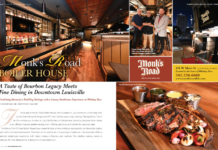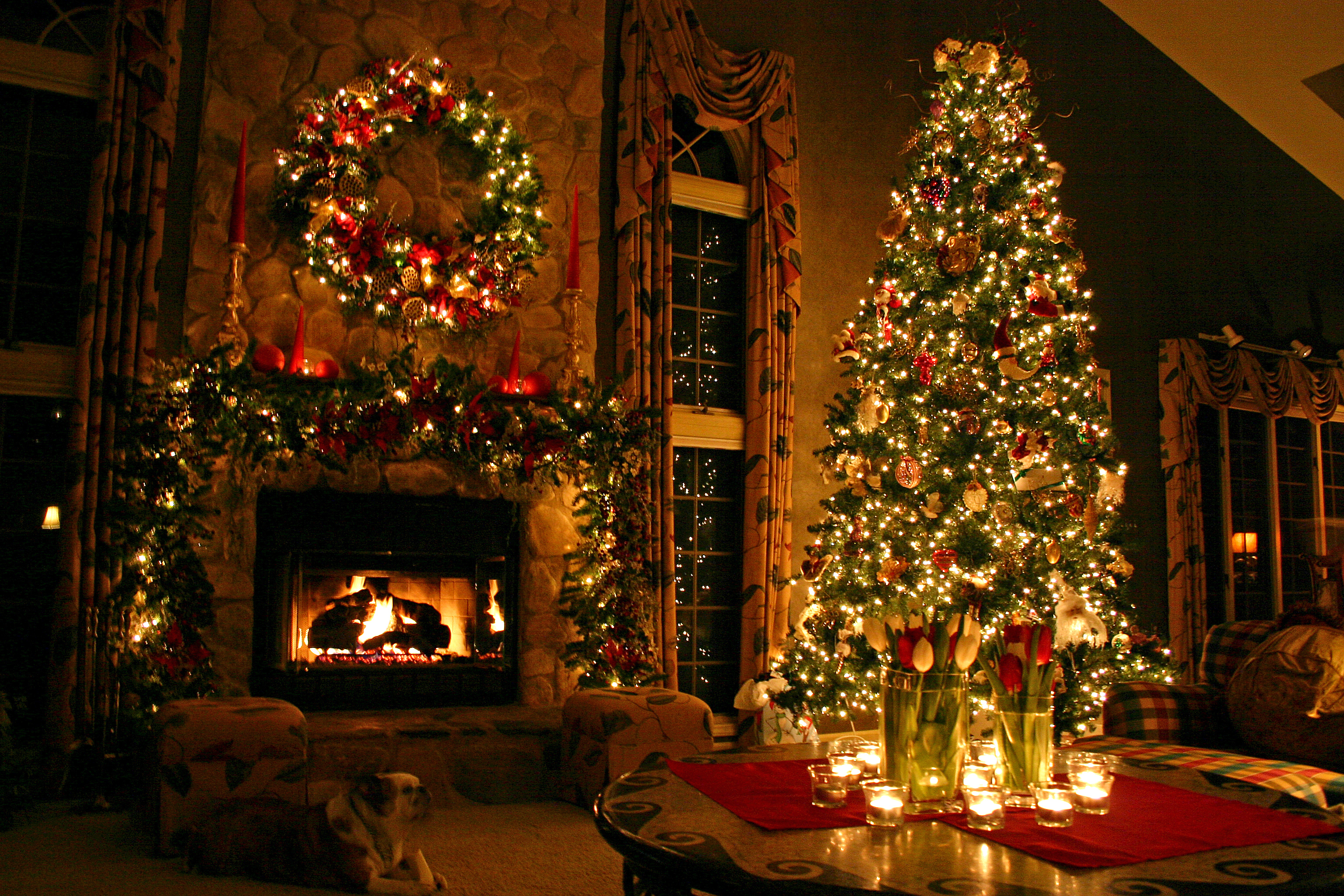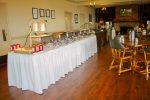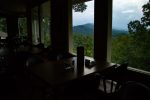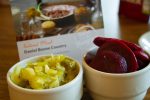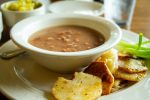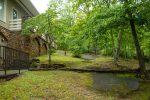Naturalist Keith Bowling told me Pine Mountain was the first state park in Kentucky, and I discovered it’s also the furthest stop from Louisville on the Taste of the Bluegrass Culinary Trail. You might not recognize the name Pine Mountain, but perhaps you’ve heard of the Cumberland Gap. I was especially looking forward to this stop because of the mountain views I had seen photos of. I wasn’t disappointed, and I would make the 3 to 4 hour trip again.
This time, it was just a couple hours to arrive, because I drove straight to Pine Mountain from Jenny Wiley State Park in Prestonsburg on a sunny day over the back roads in Eastern Kentucky. I’ve never had a reason to drive through the “hollers” of Kentucky named for the people who live there (like Rowdy or Dwarf), but I enjoyed the beautiful hills and lovely weather. I just wish I had been more prepared with my own music selection or pre-downloaded podcasts, because cell service came and went, and the radio stations were limited to two in some areas: one broadcasting christian bluegrass music and another broadcasting fire and brimstone sermons.
I passed through clusters of shopping areas and rural areas before arriving in Pikeville where the mountain loomed in front of me. I made my way easily up the mountain to the charming lodge, which has the most Kentucky cabin like interior decor of any of the parks I’ve been to so far. A pool, small amphitheater and basketball court are all within short walking distance of the lodge. The first room I encountered was a dark bar and lounge area under exposed beams and mounted game heads. I passed through this Kentucky cabin-like room into Mountain View Restaurant, which has two of the walls lined with windows, exposing a breathtaking view of the hills and valley beyond. It also featured a beautiful fireplace decorated for fall.
I met with Bowling by the windows, and I was quickly impressed with his extensive historical knowledge as I listened to him recount the history of the foods and land. It wasn’t long before the only vegetarian meal on the culinary trail was delivered, and I found a bowl of pickled beets and a bowl of chow chow in front of me thanks to Dining Room Supervisor Carolin Partin, who explained to me that chow chow is made of various vegetables. She uses cabbage, corn, cucumbers, tomatoes about to turn to ripe, bell peppers and sometimes banana peppers when she makes it. She cuts it all up, puts it in jars, and then adds a half and half mixture of boiled apple cider vinegar and water which will sweeten the chow chow and cause the jar to seal. Next, came the soup beans, fried potatoes and cornbread fritters (like cornbread pancakes).
“Around here, everyone just puts the chow chow in the pinto beans,” she explained to me. “That’s how I usually eat it.”
I was grateful for the suggestion. I did enjoy the soup beans more with the chow chow in them. The dessert was a delicious apple stack cake, and Bowling told me it’s even a traditional wedding cake for the area. Members from both the bride and groom’s families would make layers and bring them to be assembled with apple butter at the wedding, symbolizing the union.
While they sent out a serving of moonshine, I declined to taste more than a few drops on the tongue since I had to drive home. A server passed my table and asked if I had tasted the moonshine.
“I didn’t hear you scream,” he said jokingly. At least, I hope it was jokingly. If your stomach or taste buds can’t handle the included moonshine option, you can ask for milk instead.
This meal was picked to represent the region named “Daniel Boone Country,” but Bowling feels it really represents the struggles of early life in Appalachia.
He said, “I think the beets and the chow chow are examples of the creativity of the Appalachian spirit. It speaks volumes about the people that were here.”
It was during this part of our discussion that Bowling introduced me to the term “tater hole,” which I had to have him repeat a couple times to make sure I understood. Pioneers would dig a hole and put things they wanted to keep fresh in the ground, cover it with a layer of straw and add more produce on top, and so on. The ambient ground temperature of about 56 degrees would keep it better than storing it above ground. Meat was scarce, but it was often salted or smoked to keep it longer.
He went on to tell me 310,000 settlers moved through the Cumberland Gap from 1780 to 1810. Some have been misinformed that Daniel Boone was the first to discover the Cumberland Gap, but Dr. Thomas Walker was hired by the British Royal Company to survey the land in the early 1750, and his first campsite was right within the park boundaries. There were laws in place at the time that you couldn’t expand past the Appalachian Mountains, but those were soon to be lifted. Land surveyors at the time thought there would be this beautiful flat farmland past the gap, but they were wrong. (Gabriel Arthur was the first European into Kentucky in the 1600s.)
While we were talking, the rains came down and made the view from the dining room even more beautiful. Fog lifted from the hills, and I grabbed a trail map from the gift shop before exploring around the lodge a little. I could tell I was going to be disappointed that I didn’t have a few days to explore the trails, because they boast a waterfall in addition to the “chained rock” I hoped to see. The chained rock is a rock that juts out over the town of Pineville below. Local legend has it that children were worried about the rock falling, and so parents would tell them about a chain holding the rock in place but it was a lie. Later, a chain from the railroad was installed.
“The chain itself has become of tourist interest, but you’ll be greeted with a beautiful view of the gap and Pineville below,” Bowling explained.
He’s right. If you really want a view of the Cumberland Gap that will take your breath away, you can drive a few miles to hike the trail leading to the “chained rock.” Bowling described the hike as “a half mile down and three miles back” even though it’s the same trail, because it is all straight down and then back up on steps. I didn’t think I was up for that type of hike in the rain that kept coming and going. However, I drove to the trail head anyways in case it cleared up. I found a sign there pointing away from the trail towards the Pineville Overlook, and I thought I might get a nice view from there. Nice is the understatement of the year. With just a short walk up to the overlook, I found myself greeted with 180 degrees of wow for miles and miles in three directions. Words can’t do it justice, so you’ll have to check out the photos and video below.
This park was definitely the most charming if you’re looking for something that looks “stereotypical” Kentucky. Log cabin like structures and stone walls can be found throughout the park but so are signs about bears and rattlesnakes – but don’t worry. Bowling said no one’s been bitten by a snake in his whole time there, and instructions for dealing with black bears are pretty straight forward. Some of my friends commented on my social media photos to say I was in a Lord of the Rings movie, and I can see why. The whole area is enchanting. Even the golf course had a very charming layout with bridges and the mountain rising behind it. I feel like I’m going to have to return to really take in the trails and some of the other stuff they’ve got going on like mini golf, musical theater in the amphitheater and events like haunted trails.



